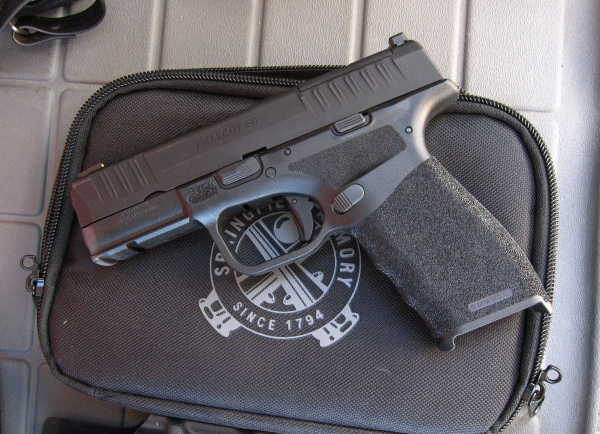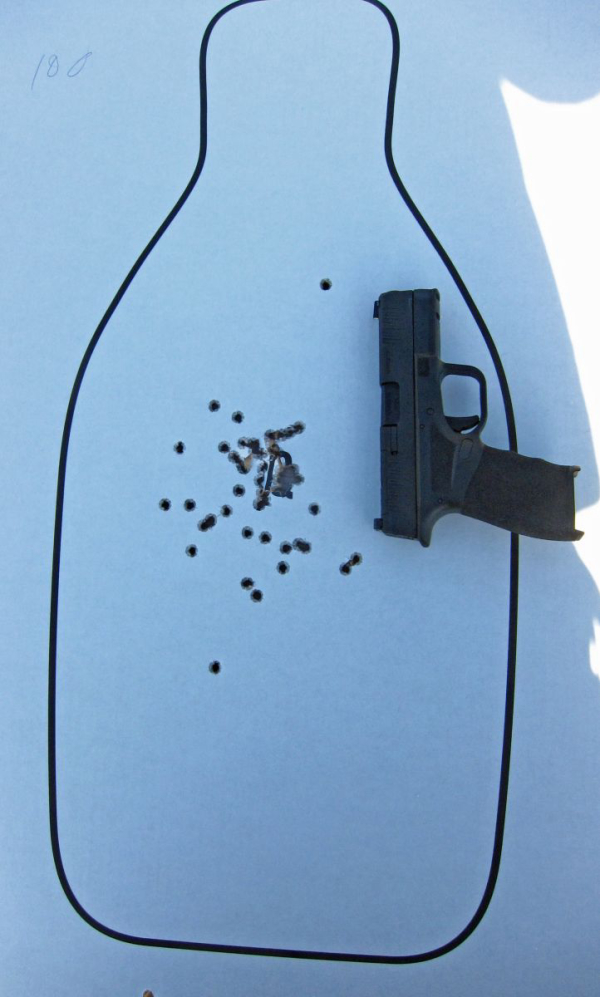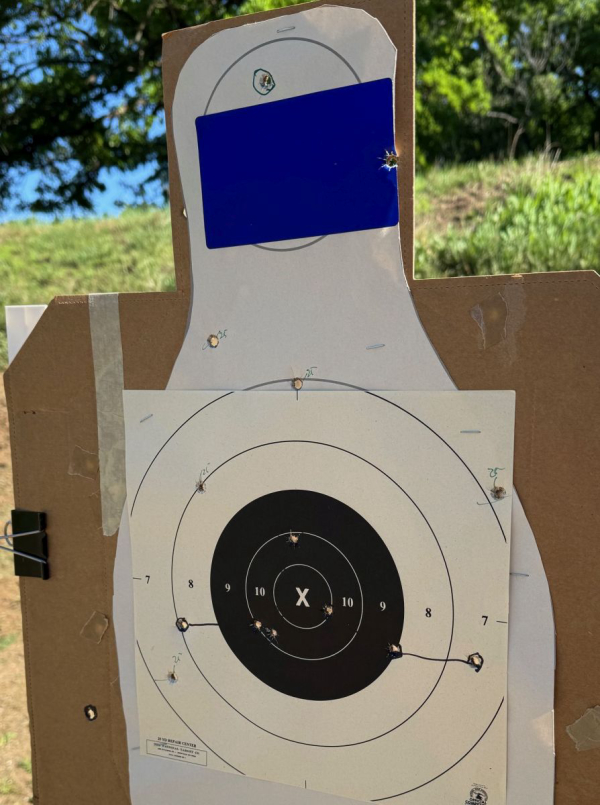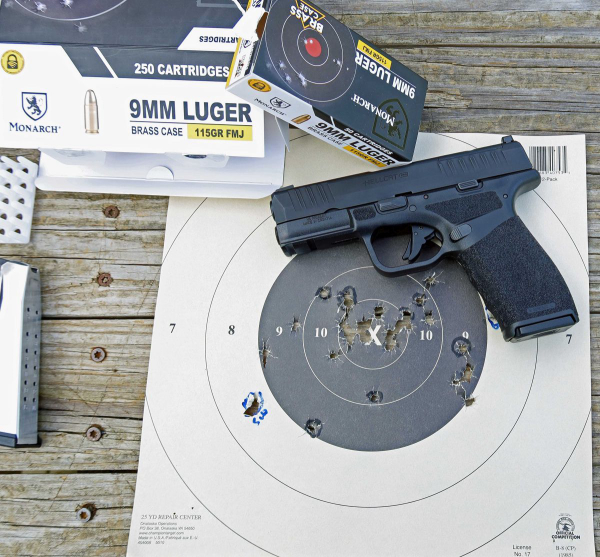In this feature, I explained my use of ammo made for police duty in the Ruger RXM. The ammo was Hornady Critical Duty 135gr. FTX +P. It’s a load geared more to service- and service-compact pistols, and I wondered how it would work with a mildly upsized micro-9. It’s “subcompact,” but with a longer barrel/slide and frame – along with magazine.


The more svelte pistol was the Springfield Armory Hellcat Pro. This gun has a shorter-than-service-compact barrel (3.7” vs. 4+”). The velocity could be short of what the 135 grain FTX bullet needs to perform. Otherwise, the gun is optics-ready, this one came with a pair of 15-round magazines, and it’s fitted with the tritium/luminescent front sight with a “tactical rack” U-notch rear sight. The frame’s grip surface is a mere one-inch wide and the gun weighs in at 21 ounces.
One question was bullet velocity from this gun vs. the 4” Ruger RXM. The other was handling; this gun is lighter, thinner, with a shorter barrel. Would that create a handling issue with the +P duty rounds?
It was mild and breezy when the morning at the range started – but it quickly got hot and I had to use some interventions to keep the target and frame standing in the wind.
First, I checked for velocity and zero from fifteen yards. The Hellcat Pro turned in a slightly higher average velocity -- 1,095 fps, compared to 1,091fps for the RXM. The rounds struck 2” high on the target, centered for windage.
The target was the IALEFI-Q training and qualification target pasted over an IDPA cardboard target. As it had already been shot, I overlaid it with a B-8 (CP) repair center and placed a 3x5 label over the upper (“head”) circle.
From 25 yards, I fired a pair from the holster, followed by a pair from low ready, twice.
I had two hits inside the circle, with 2 in the “7” rign, 1 on the repair center outside the rings, and 1 in the“neck.” One round clipped the head box. This was an inauspicious start.
From fifteen feet, I fired a pair from the holster, a pair from guard, and repeated the same one handed – dominant hand and support hand only. From here, there was a 7-ring, an 8-ring, a 10-ring hit, plus a “mike” in the -3 area of the cardboard.

It was apparent I hadn’t worked with this gun for a while.
The failure drill from ten yards yielded a pair in the 10-ring, with one in the IALEFI-Q head circle above the 3x5 label.
I worked with the same grip exercise – “switch hands” from Tenicor – to see what was happening with grip. Working at seven yards, the hits clustered closely and they were centered.
My lack of competence with the HCP was stunning. I’d shot this very gun a year before on the retiree LEOSA course and shot a tighter cluster with it than I’d previously shot with larger, “comfortable” guns.
In an attempt at remediation, I was at the range early for assessment, taking apart various components of shooting with a focus on handling the slimmer gun. I began at ten feet and ‘warmed up’ – something I normally don’t do without an assessment first – with my take on a “demand drill,” articulated by Larry Vickers. Aimed in at ten feet, using a Birchwood Casey “Dirty Bird” logo on a BC target, I had pressure on the trigger. I tried to “cut the (timer’s) beep” in half with the gunshot. My times were .18-.28 second. Going from a “muzzle 45° down” ready position to a single hit on the logo, my times were from .98 to 1.84 (the first).
I had an outlier hit at .88 second.
I did a “slow draw” exercise inspired by a drill from Travis Haley. For this, it was slow, methodical draw on the beep, counting down to the shot. I got from around 4 seconds to a hit on the B-8 (CP), staying in and around the X at ten feet, down to around 1.6 seconds. This was accomplished with a belt holster under a shirt.


I found myself failing to focus, causing one outside the 10-ring. This reinforced drawing straight up to the eyeline, then pressing out. I felt like I could get to around 1.2 seconds or so when I stopped. I ended with a pair at 1.93 seconds – putting me at two points down for time past 1.5 seconds par. I had 26 rounds fired with two in the 9-ring, five in the ten ring and the rest in the X ring.
Firing a mash-up of various qual stages proved I was nowhere near the right side of running this gun – a small gun that I shot quite well over the past few years.
At ten feet, I pushed both hits off the center zone of the target I was using. At twenty feet, still down on time, I had one in the 3”x5” vertical center zone and the other in the (ca. 6” wide) shaded zone. At thirty feet, my shooting was slow and the reload was a little sluggish, with three in the shaded area, one outside.
I went a full second and a half over at 60 feet, with one in the 3”x5” scoring zone and the other clipping the shaded area.
First, this isn’t the gun. It’s clearly the shooter and I haven’t worked it out yet. Also, I’d been carrying a gun somewhat like the Hellcat Pro for months; this was a wakeup call that I need to check competence with that.
I’m not unfamiliar with the process. I’ve been here before. Most shooters have been here, I imagine.
You just have to work it out.
— Rich Grassi